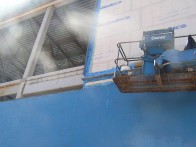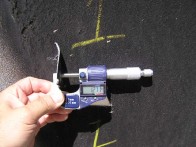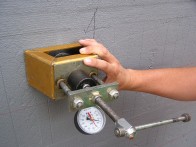Air Barrier Inspections/Field Tests (ABAA Field Audits)
Systems Building Envelope is Certified to Design, Test and Monitor USACE Air Barrier Tightness Installations and other Air Barrier Association of America (ABAA) Projects



The use of air barrier systems is becoming more prevalent within the industry. In fact, we believe that within the next decade, the installation and testing of air barriers will become common place on commercial, institutional and industrial buildings throughout the United States.
Air barriers control air leakage into and out of the building envelope. Air barrier products may take several forms including:
- Mechanically-attached membranes or house-wraps are usually a polyethylene-fiber or spun-bonded polyolefin. Tyvek is a generally accepted moisture barrier and an air barrier (ASTM E2178).
- Self-adhered membranes are also a water resistant barrier and a vapor barrier.
- Fluid-applied membranes, such as heavy-bodied paints or coatings, can include polymeric based and asphaltic based materials.
- Closed-cell, medium density. spray-applied polyurethane foam, which can provides insulation as well
- Some open-cell spray-applied polyurethane foams that are of high density.
- Board-stock, which includes 12 mm plywood or OSB, 25 mm extruded polystyrene, etc.
Air barriers are comprised of several components including:
Air barrier materials – building material that is designed and constructed to provide the principal plane of air tightness through the environmental separator and which has an air permeance rate no greater than 0.02 L/(s•m²) at a pressure difference of 75 Pa when tested in accordance with ASTM E 2178. Air barrier materials meet the requirements of the CAN/ULC S741 Air Barrier Material Specification. The air barrier materials are typically the “big” pieces of material used in an air barrier assembly.
Air barrier accessories – products designed to fasten air barrier materials, assemblies and components to the structure of the building. Examples include sealants, tapes, backer rods, transition membranes, nails/washers, ties, clips, staples, strapping, and primers. These products have an air permeance rate no greater than 0.02 L/(s•m²) at a pressure difference of 75 Pa when tested in accordance with ASTM E 2178. Air barrier components are used to connect and seal air barrier materials and/or air barrier assemblies together.
Air barrier components – these are pre-manufactured elements such as windows, doors and service elements that are installed in the environmental separator. They are sealed by air barrier accessories and have an air leakage rate no greater than 0.20 L/(s•m²) at a pressure difference of 75 Pa when tested in accordance with ASTM E 2357.
Air barrier assemblies – these are a combination of air barrier materials and air barrier accessories that are designated and designed within the environmental separator to act as a continuous barrier to the movement of air through the environmental separator. They have an air leakage rate no greater than 0.20 L/(s•m²) at a pressure difference of 75 Pa when tested in accordance with ASTM E 2357.
Air barrier system – this is a combination of air barrier assemblies and air barrier components—connected by air barrier accessories—that are designed to provide a continuous barrier to the movement of air through an environmental separator. This has an air leakage rate no greater than 2.00 L/(s•m²) at a pressure difference of 75 Pa when tested in accordance with ASTM E 779 or CAN/CGSB 149.10 or CAN/CGSB 149.15.
